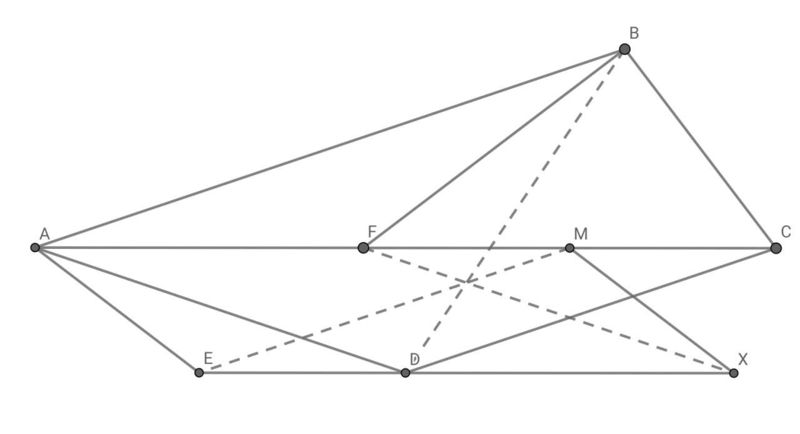Difference between revisions of "2016 IMO Problems/Problem 1"
(Added LaTeX) |
(→Solution) |
||
| (5 intermediate revisions by 2 users not shown) | |||
| Line 1: | Line 1: | ||
| + | ==Problem== | ||
| + | |||
Triangle <math>BCF</math> has a right angle at <math>B</math>. Let <math>A</math> be the point on line <math>CF</math> such that <math>FA=FB</math> and <math>F</math> lies between <math>A</math> and <math>C</math>. Point <math>D</math> is chosen so that <math>DA=DC</math> and <math>AC</math> is the bisector of <math>\angle{DAB}</math>. Point <math>E</math> is chosen so that <math>EA=ED</math> and <math>AD</math> is the bisector of <math>\angle{EAC}</math>. Let <math>M</math> be the midpoint of <math>CF</math>. Let <math>X</math> be the point such that <math>AMXE</math> is a parallelogram. Prove that <math>BD,FX</math> and <math>ME</math> are concurrent. | Triangle <math>BCF</math> has a right angle at <math>B</math>. Let <math>A</math> be the point on line <math>CF</math> such that <math>FA=FB</math> and <math>F</math> lies between <math>A</math> and <math>C</math>. Point <math>D</math> is chosen so that <math>DA=DC</math> and <math>AC</math> is the bisector of <math>\angle{DAB}</math>. Point <math>E</math> is chosen so that <math>EA=ED</math> and <math>AD</math> is the bisector of <math>\angle{EAC}</math>. Let <math>M</math> be the midpoint of <math>CF</math>. Let <math>X</math> be the point such that <math>AMXE</math> is a parallelogram. Prove that <math>BD,FX</math> and <math>ME</math> are concurrent. | ||
| + | |||
| + | [[File:2016IMOQ1.jpg|800px]] | ||
| + | |||
| + | ==Solution== | ||
| + | |||
| + | [[File:2016IMOQ1Solution.jpg|600px]] | ||
| + | |||
| + | The Problem shows that \(\angle DAC = \angle DCA = \angle CAD\), it follows that \(AB \parallel CD\). Extend \(DC\) to intersect \(AB\) at \(G\), we get \(\angle GFA = \angle GFB = \angle CFD\). Making triangles \(\triangle CDF\) and \(\triangle AGF\) similar. Also, \(\angle FDC = \angle FGA = 90^\circ\) and \(\angle FBC = 90^\circ\), which points \(D\), \(C\), \(B\), and \(F\) are concyclic. | ||
| + | |||
| + | And \(\angle BFC = \angle FBA + \angle FAB = \angle FAE = \angle AFE\). Triangle \(\triangle AFE\) is congruent to \(\triangle FBM\), and \(AE = EF = FM = MB\). Let \(MX = EA = MF\), then points \(B\), \(C\), \(D\), \(F\), and \(X\) are concyclic. | ||
| + | |||
| + | Finally \(AD = DB\) and \(\angle DAF = \angle DBF = \angle FXD\). \(\angle MFX = \angle FXD = \angle FXM\) and \(FE \parallel MD\) with \(EF = FM = MD = DE\), making \(EFMD\) a rhombus. And \(\angle FBD = \angle MBD = \angle MXF = \angle DXF\) and triangle \(\triangle BEM\) is congruent to \(\triangle XEM\), while \(\triangle MFX\) is congruent to \(\triangle MBD\) which is congruent to \(\triangle FEM\), so \(EM = FX = BD\). | ||
| + | |||
| + | ~Athmyx | ||
| + | |||
| + | ==See Also== | ||
| + | |||
| + | {{IMO box|year=2016|before=First Problem|num-a=2}} | ||
Latest revision as of 12:32, 20 April 2024
Problem
Triangle ![]() has a right angle at
has a right angle at ![]() . Let
. Let ![]() be the point on line
be the point on line ![]() such that
such that ![]() and
and ![]() lies between
lies between ![]() and
and ![]() . Point
. Point ![]() is chosen so that
is chosen so that ![]() and
and ![]() is the bisector of
is the bisector of ![]() . Point
. Point ![]() is chosen so that
is chosen so that ![]() and
and ![]() is the bisector of
is the bisector of ![]() . Let
. Let ![]() be the midpoint of
be the midpoint of ![]() . Let
. Let ![]() be the point such that
be the point such that ![]() is a parallelogram. Prove that
is a parallelogram. Prove that ![]() and
and ![]() are concurrent.
are concurrent.
Solution
The Problem shows that \(\angle DAC = \angle DCA = \angle CAD\), it follows that \(AB \parallel CD\). Extend \(DC\) to intersect \(AB\) at \(G\), we get \(\angle GFA = \angle GFB = \angle CFD\). Making triangles \(\triangle CDF\) and \(\triangle AGF\) similar. Also, \(\angle FDC = \angle FGA = 90^\circ\) and \(\angle FBC = 90^\circ\), which points \(D\), \(C\), \(B\), and \(F\) are concyclic.
And \(\angle BFC = \angle FBA + \angle FAB = \angle FAE = \angle AFE\). Triangle \(\triangle AFE\) is congruent to \(\triangle FBM\), and \(AE = EF = FM = MB\). Let \(MX = EA = MF\), then points \(B\), \(C\), \(D\), \(F\), and \(X\) are concyclic.
Finally \(AD = DB\) and \(\angle DAF = \angle DBF = \angle FXD\). \(\angle MFX = \angle FXD = \angle FXM\) and \(FE \parallel MD\) with \(EF = FM = MD = DE\), making \(EFMD\) a rhombus. And \(\angle FBD = \angle MBD = \angle MXF = \angle DXF\) and triangle \(\triangle BEM\) is congruent to \(\triangle XEM\), while \(\triangle MFX\) is congruent to \(\triangle MBD\) which is congruent to \(\triangle FEM\), so \(EM = FX = BD\).
~Athmyx
See Also
| 2016 IMO (Problems) • Resources | ||
| Preceded by First Problem |
1 • 2 • 3 • 4 • 5 • 6 | Followed by Problem 2 |
| All IMO Problems and Solutions | ||











